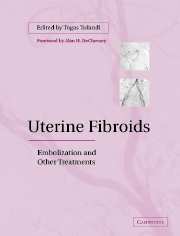Book contents
- Frontmatter
- Contents
- Contributors
- Preface
- Foreword
- 1 Uterine fibroids: epidemiology and an overview
- 2 Histopathology of uterine leiomyomas
- 3 Imaging of uterine leiomyomas
- 4 Abdominal myomectomy
- 5 Laparoscopic managment of uterine myoma
- 6 Hysteroscopic myomectomy
- 7 Myomas in pregnancy
- 8 Expectant and medical management of uterine fibroids
- 9 Hysterectomy for uterine fibroid
- 10 History of embolization of uterine myoma
- 11 Uterine artery embolization – vascular anatomic considerations and procedure techniques
- 12 Pain management during and after uterine artery embolization
- 13 Patient selection, indications and contraindications
- 14 Results of uterine artery embolization
- 15 Side effects and complications of embolization
- 16 Reproductive function after uterine artery embolization
- 17 Reasons and prevention of embolization failure
- 18 Future of embolization and other therapies from gynecologic perspectives
- 19 The future of fibroid embolotherapy: a radiological perspective
- Index
- Plate section
7 - Myomas in pregnancy
Published online by Cambridge University Press: 10 November 2010
- Frontmatter
- Contents
- Contributors
- Preface
- Foreword
- 1 Uterine fibroids: epidemiology and an overview
- 2 Histopathology of uterine leiomyomas
- 3 Imaging of uterine leiomyomas
- 4 Abdominal myomectomy
- 5 Laparoscopic managment of uterine myoma
- 6 Hysteroscopic myomectomy
- 7 Myomas in pregnancy
- 8 Expectant and medical management of uterine fibroids
- 9 Hysterectomy for uterine fibroid
- 10 History of embolization of uterine myoma
- 11 Uterine artery embolization – vascular anatomic considerations and procedure techniques
- 12 Pain management during and after uterine artery embolization
- 13 Patient selection, indications and contraindications
- 14 Results of uterine artery embolization
- 15 Side effects and complications of embolization
- 16 Reproductive function after uterine artery embolization
- 17 Reasons and prevention of embolization failure
- 18 Future of embolization and other therapies from gynecologic perspectives
- 19 The future of fibroid embolotherapy: a radiological perspective
- Index
- Plate section
Summary
Leiomyomas are the most common tumor in pregnancy, with a reported prevalence of 0.09% to 3.9%. These percentages reflect a range that on the low end indicate findings of older studies that relied on physical examination and diagnosis at the time of laparotomy or cesarean section. The upper range comes from more recent studies that utilized ultrasound examination to prospectively diagnose myomas during pregnancy. Overall, the reported prevalence of leiomyomata in reproductive age women is 20–40% with the higher rates quoted for African American women, and those with a family history of myomas. The incidence of myomas increases progressively from menarche to menopause, with rates of 50% reported at the time of autopsy. A genetic predisposition for the development of myomas has been proposed, although specific responsible genes have not been identified.
Older studies used physical examination and surgical findings for the diagnosis of myomas in pregnancy. This biased their findings toward larger and symptomatic myomas. Using ultrasound, the diagnosis of myomas in pregnancy is 1.5 to 4 times higher than previously reported. In a retrospective study, Rice et al. noted that only 25% of myomas <5 cm in diameter were detected on physical examination, and only 50% of myomas >5 cm were diagnosed when compared to ultrasound. It is clear that the use of routine ultrasound examinations increases the recognition of myomas in pregnancy.
- Type
- Chapter
- Information
- Uterine FibroidsEmbolization and other Treatments, pp. 57 - 64Publisher: Cambridge University PressPrint publication year: 2003

